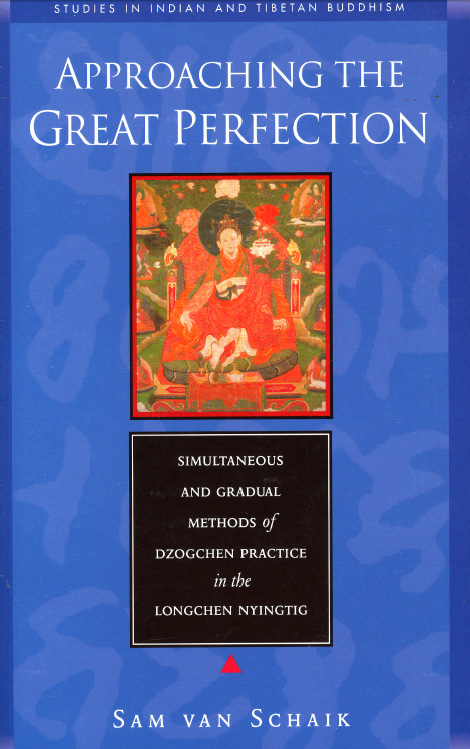Mahāmudrā and Buddha-Nature: Difference between revisions
No edit summary |
No edit summary |
||
| Line 3: | Line 3: | ||
|image=File:Vajradhara close.jpg | |image=File:Vajradhara close.jpg | ||
|imagePosition=left | |imagePosition=left | ||
|description= | |description=There are two traditions of Buddhism in India, the tradition of the deep view and the tradition of vast activity. Both originated with Buddha Shakyamuni. Noble Nagarjuna, who introduced the topic of the Buddha nature without elaborating it in detail, established the tradition of the deep view. Noble Asanga established the tradition of vast activity. Both traditions were brought to Tibet and became known as Rangtong and Shentong. Rangtong means “empty of self.” Shentong means “empty of other” and is the tradition expounding the Buddha nature that is momentarily obscured by incidental stains, which are shentong, “other than.” The Shentong School discusses, through logic, the indivisibility of emptiness and wisdom, i.e., the absence of any true reality, emptiness, that is indivisibly present with all wonderful qualities of brilliance and clarity. The treatise, The Tathagatagarbhashastra, is a Shentong text and represents the Shentong view precisely. Rangjung Dorje skilfully included the teachings on the ordinary consciousnesses, or natural mind, and linked and united them with the wondrous teachings about our spiritual heritage. This shastra is of utmost significance because it connects and unites the scholastic Shentong approach with the perfect Mahamudra Tradition of the “Magnificent Gesture and Great Seal.” | ||
<div class="text-right zoom-80"> | <div class="text-right zoom-80"> | ||
</div> | </div> | ||
Revision as of 09:32, 2 August 2019
Watch & Learn
In English with his direct, characteristic humor, Khenpo Rinpoche presents the "shining star" of buddha-nature in the minds of sentient beings as the same nature as the buddhas. He says, "We are always guided by this nature all the time whether we realize it or not."
From the Masters
Gampopa
As told by Gö Lotsāwa Zhönu Pal:
- དེ་ཡང་དྭགས་པོ་རིན་པོ་ཆེས་དཔལ་ཕག་མོ་གྲུ་པ་ལ། འོ་སྐོལ་གྱི་ཕྱག་རྒྱ་ཆེན་པོ་འདིའི་གཞུང་ནི་བཅོམ་ལྡན་འདས་བྱམས་པས་མཛད་པའི་ཐེག་པ་ཆེན་པོ་རྒྱུད་བླ་མའི་བསྟན་བཅོས་འདི་ཡིན་ཞེས་གསུངས་ཤིང་། དཔལ་ཕག་མོ་གྲུ་པས་ཀྱང་རྗེ་འབྲི་ཁུང་པ་ལ་དེ་སྐད་དུ་གསུངས་པས། རྗེ་འབྲི་ཁུང་པ་དཔོན་སློབ་ཀྱི་གསུང་རབ་རྣམས་སུ་ཐེག་པ་ཆེན་པོ་རྒྱུད་བླ་མའི་བཤད་པ་མང་དུ་འབྱུང་བ་དེ་ཡིན་ནོ།
- Moreover, Dagpo Rinpoché (Gampopa) said to Pagmo Drupa:
- "The basic text of this mahāmudrā of ours is the Mahāyānottaratantraśāstra (Ratnagotravibhāga) by Venerable Maitreya." Pagmo Drupa in turn said the same thing to Jé Drigungpa (Rje 'Bri gung pa), and for this reason many explanations of the Mahāyānottaratantraśāstra are found in the works of Jé Drigungpa and his disciples.
~ 'gos lo tsA ba gzhon nu dpal. Deb ther sngon po. Chengdu: Si khron mi rigs dpe skrun khang, 1984: Vol. 2, p. 847.
-Translation from Mathes, Klaus-Dieter. A Direct Path to the Buddha Within: Go Lotsāwa's Mahāmudrā Interpretation of the Ratnagotravibhāga. Studies in Indian and Tibetan Buddhism. Boston: Wisdom Publications, 2008: pp. 34-35.
As quoted by Śākya Chokden:
- དེ་ཡང་སྒམ་པོ་པས་གསུངས་པ། ང་ཡི་ཕྱག་རྒྱ་ཆེན་པོ་ཡི། ངོས་འཛིན་རང་གི་རིག་པ་སྟེ། གཞུང་ནི་རྒྱུད་བླའི་བསྟན་བཅོས་ཞེས།
- In that regard Gampopa says, “the hallmark of my Mahāmudrā is self-awareness and its scriptural source is the Uttaratantraśāstra”.
~ shAkya mchog ldan. gzhan blo’i dregs pa nyams byed in gsung 'bum. (Sachen International: Kathmandu, 2006), Vol. 17: p. 364.
-Translation adapted from Higgins, David and Martina Draszczyk. Mahāmudrā and the Middle Way: Post-Classical Kagyü Discourses on Mind, Emptiness and Buddha-Nature. Vienna: Arbeitskreis für Tibetische und Buddhistische Studien Universität Wien, 2016: Vol. 2, p. 17.
Further Readings
[A Direct Path to the Buddha Within]
One of the main goals of Zhönu Pal's Ratnagotravibhāga commentary is to show that the Kagyü path of mahāmudrā is already taught in the Maitreya works and the Laṅkāvatārasūtra. This approach involves resting your mind in a nonconceptual experience of luminosity or the dharmadhātu (the expanse or nature of all phenomena) with the help of special "pith instructions" (Tib. man ngag) on how to become mentally disengaged. A path of directly realizing buddha nature is thus distinguished from a Madhyamaka path of logical inference and it is with this in mind that Zhönu Pal's commentary can be called a "direct path to the buddha within."
[Grounds of Buddha-Nature in Tibet]
The distinction that Śākya Chokden makes between two types of self-awareness reflects the distinction Longchenpa made between self-awareness (rang rig) in Yogācāra (or "Mind-Only") and the gnosis of self-awareness (so sor rang rig pa'i ye shes) in the Great Perfection (rdzogs chen). Longchenpa's distinction between the basic consciousness (kun gzhi) and the Truth Body (chos sku) similarly conveys this fundamental difference between distorted and undistorted worlds. In fact, Longchenpa distinguished his view of the Great Perfection from that of "Mind-Only" in terms of buddha-nature, expressed as the "basic element" (khams):
- Proponents of Mind-Only assert a changeless permanence and mere [ordinary] awareness as self-illuminating, but this position differs because we assert the unconditioned spontaneous presence beyond permanence and annihilation, and the spontaneously present qualities of the basic element."
[Approaching the Great Perfection]
The conflict between immanence and distinction is present within the scriptural texts of the Seminal Heart, from the Seventeen Tantras down to the Longchen Nyingtig's treasure texts. And it is in the Longchen Nyingtig's treasure texts themselves that some attempt to reconcile that conflict can be detected in the frequent appearance of the buddha nature model.



